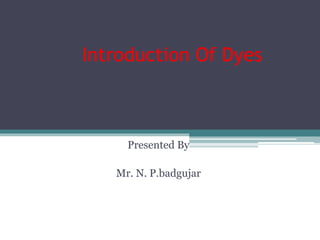
Introduction to dyes
- 1. Introduction Of Dyes Presented By Mr. N. P.badgujar
- 2. Introduction Dye: A coloured organic comp. or mixture that may be used for imparting colour to a substrate such as cloth, paper, plastic or leather. Requisites of a True Dye: Suitable colour Attractive colour. Able to attach itself. Must be water soluble Substrates being dyes must be affinity to dye. After fixation of dye, it must be fast to washing, cleaning etc. Shade & fastness of a given dye may vary depending on the substrate.
- 4. GENERAL INTRODUCTION TO THE CHEMISTRY OF DYES Dyes possess colour because 1) Absorb light in the visible spectrum (400–700 nm) 2) Have at least one chromophore (colour-bearing group), 3) Have a conjugated system, i.e. a structure with alternating double and single bonds. 4) Exhibit resonance of electrons, which is a stabilizing force in organic compounds.
- 5. • Most dyes also contain groups known as auxochromes (colour helpers), examples of which are carboxylic acid, sulfonic acid, amino, and hydroxyl groups. • While these are not responsible for colour, their presence can shift the colour of a colourant and they are most often used to influence dye solubility.
- 9. Dyes versus Pigments Solubility : organic colourants fall into two classes, viz. dyes and pigments The key distinction is that dyes are soluble in water and/or an organic solvent. Pigments are insoluble in both types of liquid media. Dyes are used to colour substrates to which they have affinity. • Pigments can be used to colour any polymeric substrate but by a mechanism quite different from that of dyes.
- 10. Classification Systems for Dyes 1. Chemical Classification: • The most appropriate system for the classification of dyes is by chemical structure, • Advantages: it readily identifies dyes as belonging to a group that has characteristic properties. EX. Azo dyes (strong, good all-round properties, cost-effective) and anthraquinone, dyes (weak, expensive). • Azo yellow, an anthraquinone red, and a phthalocyanine blue.
- 11. Usage Classification: • Classification by usage or application is the principal system adopted by the Colour Index. Because the most important textile fibers are cotton and polyester. • The most important dye types are those used for dyeing these two fibers, including polyester. cotton blends. • Other textile fibers include nylon, polyacrylonitrile, and cellulose acetate.
- 12. Classification of Dyes by Use or Application Method 1. Reactive Dyes: It possible to achieve extremely high washfastness properties by relatively simple dyeing methods . Chemical structures are much simpler, their absorption spectra show narrower absorption bands, and the dyeing are brighter. • EX. Azo (including metallized azo), triphendioxazine, phthalocyanine, formazan, and anthraquinone . • High-purity reactive dyes are used in the ink-jet printing of textiles, especially cotton.
- 13. 2. Disperse Dyes: Water-insoluble non-ionic dyes for application to hydrophobic fibers from aqueous dispersion. Used predominantly on polyester and to a lesser extent on nylon, cellulose, cellulose acetate, and acrylic fibers. Used in Thermal transfer printing and dye diffusion thermal transfer processes for electronic photography.
- 14. Direct Dyes. Water-soluble anionic dyes, when dyed from aqueous solution in the presence of electrolytes, are substantive to, i.e., have high affinity for, cellulosic fibers. Uses: dyeing of cotton and regenerated cellulose, paper, leather, and, to a lesser extent, nylon. Polyazo compounds, along with some stilbenes, phthalocyanines, and oxazines. After treatments, frequently applied to the dyed material to improve wash fastness properties. Include chelation with salts of metals (usually copper or chromium), and treatment with formaldehyde or a cationic dye-complexing resin.
- 15. 4. Vat Dyes : • Water-insoluble dyes are applied mainly to cellulosic fibers as soluble leuco salts after reduction in an alkaline bath, usually with sodium hydrogen sulfite. • The leuco forms are reoxidized to the insoluble keto forms and after treated, usually by soaping, to redevelop the crystal structure. • The principal chemical classes of vat dyes are anthraquinone and indigoid.
- 16. 5.Sulfur Dyes: • These dyes are applied to cotton from an alkaline reducing bath with sodium sulfide as the reducing agent. Numerically this is a relatively small group of dyes. • The low cost and good wash fastness properties of the dyeing make this class important from an economic standpoint.
- 17. 6. Cationic (Basic) Dyes: • Water-soluble cationic dyes are applied to paper, polyacrylonitrile modified nylons, and modified polyesters. • Using for silk, wool, and tannin-mordanted cotton when brightness of shade was more important than fastness to light and washing. • Basic dyes are water-soluble and yield colored cations in solution. • Principal chemical classes are diazahemicyanine, triarylmethane, cyanine, hemicyanine, thiazine, oxazine, and acridine. • Some basic dyes show biological activity and are used in medicine as antiseptics.
- 18. 7. Acid Dyes: • Water-soluble anionic dyes are applied to nylon, wool, silk, and modified acrylics. • Used to some extent for paper, leather, ink-jet printing, food, and cosmetics.
- 19. 8. Solvent Dyes: • Water-insoluble but solvent-soluble dyes are devoid of polar solubilizing groups such as sulfonic acid, carboxylic acid, or quaternary ammonium. • Used for coloring plastics, gasoline, oils, and waxes. • The dyes are predominantly azo and anthraquinone, but phthalocyanine and triarylmethane dyes are also used.
